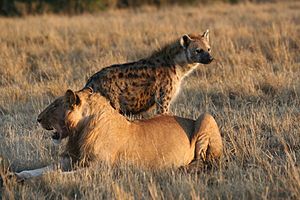Interspecific competition facts for kids
In the natural world, different kinds of animals and plants often need the same things to survive. When they try to get these same things, like food, water, or a place to live, they are "competing." This idea is called interspecific competition. It happens when individuals from different species (different types of living things) compete for the same limited resources in an ecosystem.

Contents
What is Interspecific Competition?
Imagine a forest where different animals live. A deer needs grass to eat, and a rabbit also needs grass. If there isn't enough grass for both, they are in interspecific competition. This competition isn't always about fighting. It can be as simple as one animal eating the food before another gets to it, or one plant growing taller and blocking sunlight from another.
Resources that species compete for include:
- Food: Like the deer and rabbit example, or different types of birds trying to eat the same insects.
- Water: Especially in dry places, all living things need water.
- Space or Territory: Animals need places to live, hunt, and raise their young. Plants need space to grow their roots and leaves.
- Light: Plants compete for sunlight, especially in dense forests.
- Nutrients: Plants also compete for nutrients in the soil.
Sometimes, species don't even have to meet to compete. For example, two different kinds of predators might hunt the same type of prey animal. If one predator eats a lot of the prey, there will be less for the other predator.
Why is Interspecific Competition Important?
Interspecific competition is a very important part of ecology, which is the study of how living things interact with each other and their environment. It helps to:
- Regulate Populations: Competition helps control how many individuals of each species can live in an area. If there are too many of one species, they might run out of resources.
- Drive Natural Selection: When species compete, the individuals that are better at getting resources are more likely to survive and reproduce. This is a key part of natural selection.
- Cause Evolution: Over long periods, natural selection can lead to evolution. Species might change their behavior or even their bodies to become better competitors or to avoid competition altogether. For example, a species might start eating a different type of food.
Interspecific vs. Intraspecific Competition
It's important to know the difference between interspecific competition and another type of competition:
- Interspecific competition is when individuals from different species compete for resources.
- Intraspecific competition is when individuals from the same species compete for resources. For example, two male lions might fight over a female lion or a hunting territory.
Both types of competition are natural and play a big role in shaping the natural world around us.
Images for kids
-
Naturalised purple-loosestrife plants growing in the Cooper Marsh Conservation Area, near Cornwall Ontario.
See also
 In Spanish: Competencia interespecífica para niños
In Spanish: Competencia interespecífica para niños


